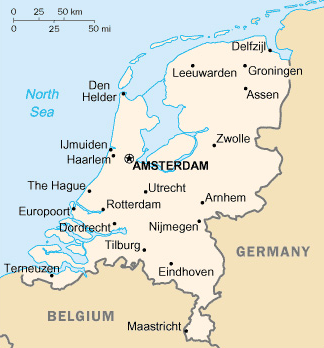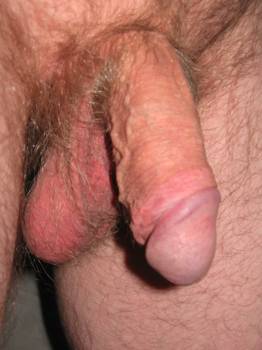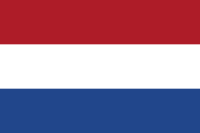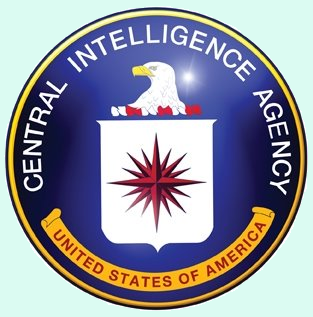 |
 |
| Left - The Netherlands in relation to other member states of the European Union. The Netherlands is a founder member of the European Union, NATO and the Euro Currency Zone. Right - the boundaries of The Netherlands in relation to its immediate neighbours Belgium and Germany. |
|
The Dutch Republic.
The beginning of the modern Netherlands came with the formation of the Dutch Republic in 1481, when the provinces of Holland, Zeeland, Groningen, Friesland, Utrecht, Overijssel, and Gelderland overthrew Burgundian role and formed a federation. Very soon they got handed an unexpected and hugely valuable gift. At the time Spain and Portugal were the world's most successful maritime nations, with huge overseas territories. However religious fervour led to both countries expelling Jews and Muslims in the last decade of the 15th century. Since their leading mathematicians and cartographers were all Muslim or Jewish, at one stroke this brought about the decline of their maritime supremacy. The new, and tolerant, Dutch Republic welcomed these exiles - and made use of them, soon taking over the mantle of the world's leading maritime power. It is no exaggeration that Dutch success was brought about by circumcised people.
 |
In due course this led to the formation of the Dutch East India Company (the Vereenigde Oost-Indische Compagnie or VOC in Dutch) in 1602. The VOC was a chartered company established by the States-General of the Netherlands, initially granted a 21-year monopoly to carry out colonial activities in Asia. It was the first multinational corporation in the world and the first company to issue stock. It was also arguably the world’s first megacorporation, possessing quasi-governmental powers including the ability to wage war, negotiate treaties, coin money, and establish colonies. |
Statistically, the VOC eclipsed all of its rivals in the Asia trade. By comparison the English (later British) East India Company was a distant second, its total traffic a mere one-fifth the tonnage of goods carried by the VOC. The VOC enjoyed huge profits from its spice monopoly through most of the 1600s. The Dutch East India Company remained an important trading concern for almost two centuries, paying an 18% annual dividend for almost 200 years. In its declining years in the late 18th century it was referred to as Vergaan Onder Corruptie (referring to the acronym VOC) which translates as 'Perished By Corruption'. The VOC became bankrupt and was formally dissolved in 1800, its possessions and the debt being taken over by the government of the Dutch Batavian Republic. The VOC’s territories became the Dutch East Indies and were expanded over the course of the 19th century to include the whole of the Indonesian archipelago.
Despite the Low Countries coming under French domination in the years 1795–1814, the Dutch influence in the Indonesian archipelago continued until the Second World War. The combined effects of the German invasion of the Netherlands in 1940 and the Japanese invasion of the Netherlands Indies in 1942 sealed the fate of the Dutch colonial era.
The latest border change in Dutch history has occured as recently as 10th October 2010, with the dissolution of the Caribbean state of the Netherlands Antilles. One fragment, the “BES Islands” (Bonaire, Sint Eustatius and Saba), has been absorbed into the Netherlands proper, in effect becoming a tiny new outpost of Europe in a far-away place. The population (numbering some 18,000 in total) has chosen to adopt the US Dollar rather than the Euro as currency, creating a strange new financial situation within the Dutch system of government.
Consequences as regards circumcision
Islam reached the Indonesian archipelago many centuries before the VOC. Therefore it can be said with some certainty that high rates of circumcision existed in the eastern Dutch colonies from the outset of their conquest. First noted in the 11th century, by the end of the 16th century, Islam, through conversion, had surpassed Hinduism and Buddhism as the dominant religion of the peoples of Java and Sumatra. At this time, only Bali retained a Hindu-practising majority, and the eastern islands remained largely animist but would adopt Islam and Christianity in the seventeenth and eighteenth centuries. Many of these people migrated to the Netherlands, though in post-colonial times it was probably the uncircumcised Christian Indonesians, facing Muslim opposition, who were most likely to migrate.
During the second half of the twentieth century, the Netherlands accepted a number of economic migrants from Turkey, notwithstanding that Turkey is not (and never has been) either a member of the EU or a Dutch colony. The result is that approximately 2.2% of the population is of Turkish extraction. A similar influx from Maroc (Morocco) added a further 2% of predominantly Muslim immigrants. The Netherlands in the present day has a population approximately 7% of whom might be expected to circumcise for religious or cultural reasons, this being the total of Indonesian, Turkish, Moroccan and Jewish groups.
The 21st century rise of the far right neo-Nazi movements has not bypassed the Netherlands amd this has led to calls to ban religious circumcision. Maybe these people need a history lesson about what led to their country's historical greatness. More worrying was a call from the left also seeking to (effectively) ban religious circumcision, particularly for Jews. In an op-ed published in May in the left-wing daily NRC Handelsblad, the Jong Democraten’s chairman, Wouter van Erkelens, and spokesman Koen Sijtsema argued in favour of implementing a government policy that would discourage all non-medical circumcision of children. The Jong Democraten is the youth wing of the D66 party, the Netherland's third party and hence a significant player. Fortunately Roy Kramer, a senior spokesman for the D66 party, distanced himself from the piece, saying that the party had no official view on circumcision and saw no need to have one. Read more here.
Medical practitioners’ attitudes towards circumcision
The The Royal Dutch Medical Association (KNMG) has published a document available in both English and Dutch that is strongly opposed to the circumcision of minors. It includes this statement:
Non-therapeutic circumcision of male minors is contrary to the rule that minors may only be exposed to medical treatments if illness or abnormalities are present, or if it can be convincingly demonstrated that the medical intervention is in the interest of the child, as in the case of vaccinations.With so much evidence building to the effect that circumcision is, in effect, surgical vaccination against a plurality of conditions, their choice of words seems especially inappropriate. Frankly, the only way to make sense of this statement is that it is racially motivated. Fortunately, male circumcision on parental initiative remains legal in the Netherlands despite KNMG’s hostility.
So where should I go to get myself or my son circumcised?
The following Dutch websites advertise circumcision services in Dutch in a number of convenient locations within the country including Alkmaar, Almere, Amsterdam, Apeldoorn, Arnhem, Breda, Den Haag, Maastricht, Rozendaal, Rotterdam, Utrecht and Zaandam.
http://www.algitaan.nl
http://www.medinova.com/medinova/onze-klinieken/kliniek-klein-rosendael
http://www.besnijdeniscentrum.nl
http://www.besnijdeniskliniek.nl/
http://www.parkstadkliniek.nl/
The SmartKlamp was developed in the Netherlands
The Netherlands has a place in the history of development of single-use circumcision clamps. Although now produced by a company based in Malaysia, the research and development work associated with the SmartKlamp was, during the latter half of the 1990s, done by a company based in Hengelo and run by Dr. Harrie van Baars.
Found on an ‘Agony Aunt’ page
Dorien (19): “Mijn vriend had het er laatst over dat hij zijn voorhuid wil laten weghalen. Hij wist niet waar hij naar toe moest en ik ook niet. Waar kan mijn vriend zich laten besnijden?”
Translation: My friend was recently thinking about getting his foreskin removed. He doesn’t know where to go, and me neither. Where can my friend get circumcised?
Bijna elk ziekenhuis heeft een polikliniek die besnijdenissen uitvoert. Laat je vriend dus een ziekenhuis in de buurt bellen en om informatie vragen. Hebben ze een wachtlijst, dan kan hij altijd een ander ziekenhuis proberen. Hij kan bij zijn huisarts informeren naar een goed adres in de buurt. Een besnijdenis is een kleine operatie, die meestal poliklinisch wordt uitgevoerd, onder plaatselijke verdoving.
Translation: Almost every hospital has a polyclinic that carries out circumcisions. Get your friend to ring up a hospital in the neighbourhood to ask for information. If there’s a waiting list, he can always try another hospital. He can get a good address in the neighbourhood from his GP. A circumcision is a little operation that is mostly done in a polyclinic under local anaesthetic.
CIRCLIST Member experiences
I wanted to be cut, but I did not know any doctors, who would perform the operation without an medical reason. Moreover, when you asked to be cut the doctors would directly jump to the conclusion that you would only ask the question when you’re gay.
In The Netherlands, there is a foundation (the Rutger Stichting) who advise people on all sorts of sexual subjects. After some hesitation, I went to their normal consulting hour. The doctor I saw, was very cooperative and did not ask any nasty questions. He did not discuss the cut itself, nor how tight I wanted the cut. Even if he had asked, I would not have known what to answer, because at that time I thought "circumcised is circumcised". Then he told me he knew a surgeon who would do the operation in a military hospital. That was very convenient because I was in the military service at that moment. So within 2 weeks I was taken in the hospital and next day got my operation under local anesthesia. After another night in the hospital I could return home. And because I was a military person, the operation was free! The stitches fell out after about one week and the wound healed very quickly. After that week I masturbated my circumcised dick for the first time. The feeling was incredibly intense and the climax hardly bearable.
Although our two sons were cut (due to phimosis) shortly after birth, my wife did not at first like my cut status. However, after some time she grew accustomed to the situation, overcame her hesitations and eventually dared to touch the glans. That was more than 25 years ago. I’m still proud of my circumcision and enjoy the feeling when making love. There IS a difference and I like it. You don’t have to keep the foreskin back and the rim is much more sensitive. I tore my frenulum long before I was circumcised, and now I know I have a reasonable tight cut, however not as high a I see sometimes in pictures in this forum.
In The Netherlands about 10 to 15% of the males are circumcised, either because of religion (Islam is the second religion in the Netherlands) or because of medical reasons. Due to a posting in a NATO position, I was able to compare the "cut rate" of a couple of other NATO nations. The cut rate of German military personnel is comparable to the one in the Netherlands, but I never saw an uncut US military person.
Fred - The Netherlands
----------
 |
In 2005 the government decided that medical insurance should no longer pay for circumcision; an attempt to reduce costs for the health system and maybe also out of anti-Islamic sentiments among some politicians. A group of doctors responded to this by setting up circumcision centers (www.besnijdeniscentrum.nl) where they perform the operation at relatively low cost using local anesthesia. I myself was cut there at the age of 50; the result is shown in the photograph. Originally they mainly treated Muslim boys, but they circumcise adult men as well - not only on religious grounds. Gradually more and more adult men get treated at one of these centers for hygienic, aesthetic and/or sexual reasons. Willem - The Netherlands |
Acknowledgements
The following resources were used in the preparation of this web page:
Personal testimony of members of the CIRCLIST discussion group.
Wikipedia
The CIA World Factbook (accessed 31.October.2010).
Maps courtesy of www.youreuropemap.com and the US Central Intelligence Agency.





